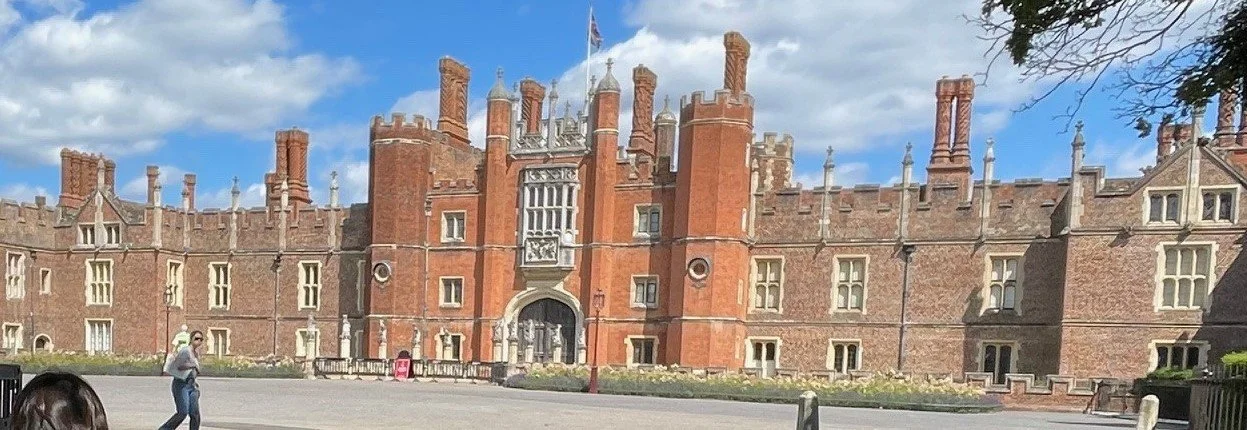2025 BIKE & SKETCH TOUR / Walton-on-Thames to Richmond
Fiona Mckay
Relaxing at Hampton Court. Photo Credit: S Nalin
Lunch at Hampton Court An AIA UK Bike Tour is not all hard riding, sweat and tears. Sometimes there are breaks for contemplation and enjoyment of the British countryside. Saturday, 28 Jun 2025 proved to be one of the hottest days of the year (to date!) and the shady environs of Hampton Court offered the riders a chance to contemplate, catch their breath, have lunch, cool down and – yes - sketch. Lest we forget, the Bike Tour is also a Sketch Tour, and sketching can be relaxing.
Hampton Court in Full Glory. Photo Credit: B O’Looney
Souvenirs of the Day. Sketch Credits (Left to Right): B O’Looney, G Fonseca, M Yao
Back to the Start at Walton-on-Thames Admittedly, this year’s Bike & Sketch Tour was not all that arduous. It started under the guidance of AIA UK’s favourite guide Benedict O’Looney ARB in Walton-on-Thames with a long downhill ride from the train station to the Thames path. From there to Richmond was flat and easy. It was only the weather that proved difficult and discouraged at least two other potential riders on the day.
Walton-on-Thames – like other small English towns - has its share of obscure historical stories to tell. It is claimed – for example - that Julius Caesar forded the River Thames at Walton on his 2nd invasion of Britain; it is known that Canaletto painted the 1st of 6 Walton Bridges in 1754; and it is documented that the 1st ever baseball game was played nearby in 1749.
Not being able to pursue such stories in person, the Bike & Sketch Tour made its first major stop at a prominent – and very down to earth - heritage site. Walton’s St Mary’s Parish Church is a largely 12th century structure that also contains relics of Saxon material and significant later additions. O’Looney explained the complex history of the church in his usual exquisite detail.
In particular, he was able to highlight an unexpected treat – the superlative 18th century Boyle Monument by Louis-Francois Roubiliac, a French sculpture who worked in England. Roubiliac is described in Wikipedia as ‘probably the most accomplished sculpture ever to work in England’ – an epitaph that is hard to ignore.
Exploring St Mary’s in Walton on Thames, Including the Boubiliac’s Monument. Photo Credits (Clockwise from Top Left): L King, B O’Looney, G Fonseca, B O’Looney
Along the Thames Path to Hampton Court After a search for suitable access to the Thames Path, the riverside ride began in earnest with a chance to enjoy the gentle ambience of river life – pubs and marinas; kayakers and paddle boarders; locks and weirs; bridges and footpaths - the accumulated dynamics of upstream Thames.
Thames Life. Photo Credits (Clockwise from Top Left): E Fitzpatrick, G Fonseca, E Fitzpatrick
As well as his detailed knowledge of ecclesiastical architecture, O’Looney also instils his tours with the economic, social and environmental history found along the way.
For example, Platt’s Eyot seen across a river filled with expensive looking pleasure boats proved to have been an important ship building centre when the Thames was more than just a recreational diversion. In 1904, John Thornycroft set up the Hampton Launch Works on the island where small naval craft and torpedo boats were built during both World Wars. Abandoned since the 1960s, the last remaining factory shed is now sadly decrepit and unlikely ever to be listed.
Platt’s Eyot and the Thorneycroft Works. Photo Credit: S Nalin
After Lunch, Hampton Court Close Up The Thames path from Hampton Court to Kingston held more architectural treasurers, not least of which were the chimney laden rooflines and the back gate to the palace gardens.
Looking Closely at Hampton Court. Photo Credit: B O’Looney and G Fonseca
Meandering Through the Richmond Throngs After Kingston and a quick stop to admire Teddington Lock, the tour continued to Richmond. The Richmond River Terrace – usually filled with boisterous crowds against a backdrop of Quinlan Terry’s faux classical buildings – was a desert of parched grass. The weather was not just hot; it also produced a near desert in SW London. Instead of sitting on the scraggly dunes, the crowds promenaded on the Thames Path. It took skill and courage to manoeuvre bikes safely around the walkers, up the hill, through the traffic to the final destination – Richmond Station.
Richmond Station Although Hampton Court was admittedly a hard act to follow, the renovation of Richmond Station proved the highlight of the Bike & Sketch Tour, given that t O’Looney’s firm – Benedict O’Looney Architects - was the renovation architect on behalf of South Western Railway and the Railway Heritage Trust. As tour guide, O’Looney was able to describe his own project in intimate detail.
Since his work on the Peckham Rye Station (see HERE), O’Looney’s reputation for meticulous historic research and detailing has soared. The art deco façade and – where possible - parts of the booking hall are now being restored to their former glory. Particular attention has been placed on the signage as well as the design and manufacture of a replacement for the front canopy.
Details of the restoration work can be found HERE.
Richmond Station Gets a Facelift. Photo Credits: G Fonseca and L King
This year’s Bike & Sketch Tour was organised by Etain Fitzpatrick AIA RIBA and earned the participants 5 continuing education credits. Due to safety concerns, participation in AIA UK Bike Tour can be restricted. If you are interested in next year’s tour, it is a good idea to book early.
Written by Lorraine King AIA








